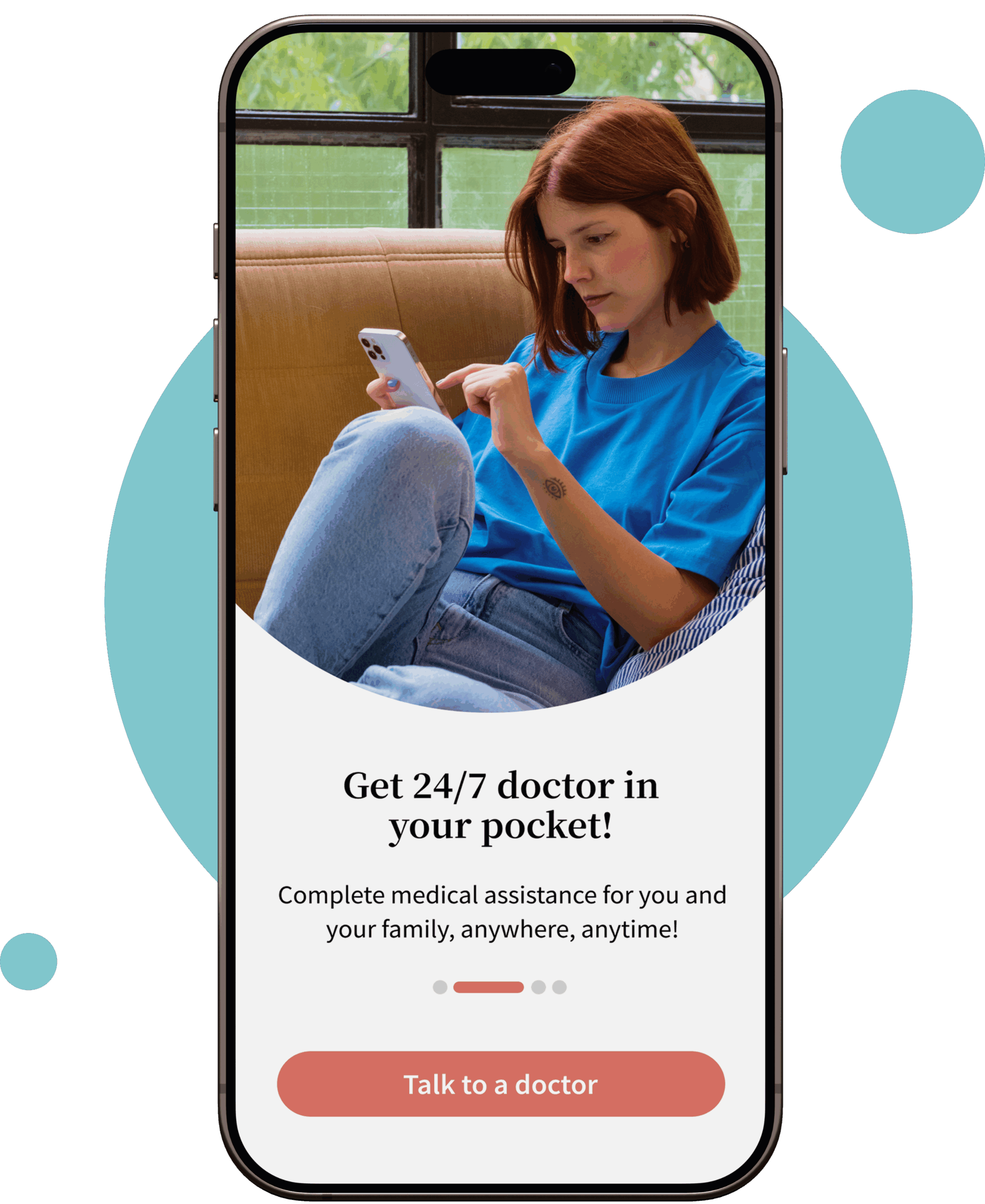
See a doctor on your schedule and get online strep throat treatment and antibiotics anytime.
Skip the germ-packed waiting rooms and get online treatment for a sore throat within minutes. Whether your strep throat hits at midnight or mid-afternoon, Your Doctors Online connects you to a board-certified physician within 5 minutes. Start your virtual visit instantly, receive a diagnosis, and have antibiotics prescribed directly to your local pharmacy. Feel relief faster with immediate online care.
Get rid of strep throat overnight with Your Doctors Online
Relieve sore throat symptoms fast by connecting with our licensed online physician.
1
Describe your symptoms
Download our app, register, and tell us about your sore throat symptoms to get started.
- Strep Throat
- STD
- UTI
- Sexual Health
- Skin
- Covid
2
Chat with a doctor
Connect with a board-certified doctor. You can chat, send pictures, and videos to get a virtual diagnosis of strep throat.
Hi I’m Dr. Nicole. How may I help you?
Hi Dr. Nicole, I have a fever and a terrible sore throat. Can I get antibiotics for that, please?
3
Get online prescription
Receive your prescription for strep throat at your desired pharmacy within minutes once a diagnosis is established.
Prescription
- Azithromycin 250mg, two tablets on day 1 and then one tablet for the next 4 days
- Benzydamine HCl Gargles 0.15% solution, thrice daily for 7 days
Send Prescription
What are strep throat symptoms??
Strep throat is a bacterial infection that, unlike a sore throat from a cold, develops suddenly and causes intense pain and inflammation. Common symptoms include:
- Severe sore throat that begins abruptly
- Red, swollen tonsils sometimes with streaks of pus
- Swollen, tender lymph nodes in the neck
- Fever of 100.4 °F
- Tiny red spots (petechiae) on the roof of the mouth
- Headache, nausea, or abdominal pain in children
- No cough or runny nose
- Muscle aches and Loss of appetite in some individuals
What Causes Strep Throat?
Strep throat is caused by Group A strep bacteria. These bacteria enter your body when someone with the infection coughs, sneezes, or even talks, releasing tiny droplets full of bacteria into the air. If you breathe in those droplets or touch a contaminated surface and then touch your mouth or nose, the bacteria can infect your throat.

Online treatment for strep throat
Our online treatment starts by connecting you with a licensed doctor via video or phone within minutes. During the virtual consultation, the doctor will thoroughly assess your symptoms, review photos or video of your throat, and determine if you have strep throat. If diagnosed, your doctor can immediately prescribe the first line of antibiotics:
- Penicillin prescription, like Amoxicillin
- Azithromycin prescription (If you are allergic to penicillins)
Individuals with strep throat are advised to take antibiotics for 5-10 days. It’s important to note that antibiotics may take a few days to affect and improve symptoms fully. You’ll also receive practical advice for symptom relief:
- Staying hydrated
- Pain relievers
- Warm water gargles to soothe your throat
Strep throat medication we prescribe
Antibiotic
Learn MoreAntibiotic
Learn MoreAntibiotic
Learn Moreantibiotic
Learn Moreantibiotic
Learn MoreFAQs about treating strep throat through telehealth clinic
Can I get a prescription for strep throat online?
Online doctors, as licensed medical providers, can prescribe strep throat medication. You can collect your prescription from a local pharmacy or request home delivery from an online pharmacy.
Is strep throat the most painful?
Strep throat is painful and more severe than the viral infection causing sore throat. It causes painful swallowing, loss of appetite, and sudden sore throat without a cough. See a doctor if you experience the onset of these symptoms for timely treatment online.
How fast does amoxicillin work for strep?
Amoxicillin typically takes around 72 hours to relieve strep symptoms in most cases. Some individuals may notice improvement within 24 to 48 hours. Always inform your healthcare provider if antibiotics do not produce the expected results.
How long does strep throat last without antibiotics?
Strep throat usually resolves in three to five days without treatment. However, antibiotic use is recommended to prevent complications. Symptoms typically improve within one to three days after starting antibiotics.
Does strep throat cause throat ulcers?
No, strep throat caused by bacteria does not cause cough, ulcers (laryngitis), or runny nose. These are the symptoms of a viral infection mostly. Consult a doctor for the proper diagnosis of the condition.
What does strep throat look like?
Strep throat causes swallowing pain, sore throat, pus-filled tonsils, redness, and swollen lymph nodes. See a doctor if you experience these symptoms.
Can strep cause stomach pain and diarrhea?
Strep throat may accompany other symptoms like diarrhea and stomach pain. However, in most cases, the cause of stomach pain and diarrhea is antibiotic treatment. Almost all antibiotics have diarrhea as a side effect.
How long does a headache last with strep throat?
Strep throat may accompany symptoms like headache, fever, loss of appetite, throat infection, and pain. Headache usually lasts 1-3 days with strep throat and improves with treatment.
How long does strep throat usually last?
Strep throat takes 7-10 days to heal with antibiotics. However, without treatment, it can worsen and extend over ten days. It is recommended to complete the antibiotic course to avoid the risk of complications even if your symptoms heal within 1-3 days.
Can you treat strep without antibiotics?
Without antibiotics, the bacterial infection cannot be treated. However, to reduce the severity of symptoms like pain and inflammation, nonsteroidal anti-inflammatory drugs (NSAIDs) can be used both over the counter and upon prescription. See a doctor for the prescription of antibiotics without leaving your home via a virtual telehealth clinic.
How can I get rid of strep throat fast?
You can get rid of strep throat fast if you start an antibiotic course within 48 hours of the infection, which reduces the severity and duration of the infection. It also reduces the chances of contagious infection and the risk of developing complications.
What is the best medicine for strep throat?
The best medicines for strep throat include penicillin and amoxicillin. However, if you are allergic to penicillin-type antibiotics, your provider may prescribe alternatives like cephalosporins, clindamycin, or azithromycin.
What are the 3-day antibiotics for strep?
For strep throat, the antibiotic taken for three days is azithromycin (Z-pack). It starts easing the symptoms with the first dose, and the treatment lasts only three days.
How do you know if strep is viral or bacterial?
Strep throat accompanies cough, runny nose, and throat swelling in viral infection. However, in the case of bacterial infection, there is no cough; instead, stomach aches, nausea, vomiting, and fever accompanies.
Why do I have a sore throat but not sick?
A sore throat doesn’t always indicate bacterial or viral infection rather can be a symptom of another medical issue. It can also indicate allergies, acid reflux, STI, or cold.
Does all strep throat need antibiotics?
As it is a viral infection, you may catch an infection from an infected person. It can infect you if you show symptoms or be asymptomatic if you are a carrier. Infected persons need antibiotics however, the carrier doesn’t. The chances are less for you to spread the infection or cause complications if you are just the carrier.
How soon can a doctor tell if you have strep?
A doctor can diagnose strep throat via symptoms or a swab test, which takes two days. In the case of strep throat, the cause is a virus, and the infection stays for 2-5 days, along with mild to severe fever. See a doctor for the diagnosis and treatment of the strep throat infection.
Where can I get antibiotics for strep?
You need a doctor’s prescription to obtain antibiotics, usually after undergoing symptom evaluation and a strep throat test to confirm diagnosis.
How long is a person contagious with strep throat?
People who start antibiotic treatment become less contagious within about 24 hours. However, those untreated can spread the bacteria for up to two weeks. Symptoms usually appear 2-5 days after exposure.
Can I treat strep throat without seeing a doctor in person?
Yes, you can effectively treat strep throat without an in-person doctor visit by using our online doctor service. Our telehealth providers will ask about your symptoms and health history and may visually examine your throat over video. If you meet the criteria for strep throat, the doctor will prescribe the appropriate antibiotics online. You can then receive the prescription at your local pharmacy.
Is online strep throat diagnosis accurate?
Online strep throat diagnosis is both accurate and safe when conducted by a reputable telehealth provider following clinical, HIPAA, and PIPEDA guidelines. Online doctors use standardized scoring systems based on your symptoms, and may visually inspect your throat via video. Many key signs (red throat, white spots) are observable on camera or in photos. If uncertain, your doctor will recommend a rapid strep test at a local pharmacy or lab to confirm the diagnosis.
How soon can I get a medication for strep throat online?
Although the times vary from one telehealth provider to another, with Your Doctors Online, you can get an antibiotic prescription within 5 minutes.
Do I need a strep test before getting antibiotics online?
A rapid strep test (or throat culture) is ideal to distinguish bacterial strep from a viral sore throat before prescribing antibiotics. We will refer you to a local clinic when symptoms aren’t classic. However, if your presentation is strongly indicative (high fever, no cough, swollen, pus-covered tonsils), a physician may use clinical judgment and scoring based on symptoms to prescribe antibiotics and advise follow-up testing, if required.
How fast does amoxicillin work for strep?
Amoxicillin takes around 72 hours to relieve strep symptoms in most cases. Some individuals may notice improvement within 24 to 48 hours. Always inform your healthcare provider if antibiotics do not produce the expected results.
How long does strep throat last without antibiotics?
Strep throat without antibiotics lasts about 7–10 days. However, untreated strep significantly increases the risk of serious complications such as rheumatic fever or kidney inflammation. Using antibiotics shortens symptoms dramatically, often relieving discomfort within 24–48 hours and preventing contagious spread within about a day.
What does strep throat look like?
Strep throat appears as red, inflamed tonsils, often covered with white or yellowish patches of pus. The throat may look red and irritated, with small red dots (petechiae) visible on the soft palate. Swollen lymph nodes under the jaw or along the neck often accompany this appearance.
Can strep cause stomach pain and diarrhea?
While not always, strep throat can cause stomach pain, nausea, and even diarrhea, especially in children. While throat pain is the hallmark symptom, gastrointestinal symptoms like stomach discomfort and vomiting are common in younger patients. These symptoms result from toxins produced by the Streptococci bacteria.
How can I get rid of strep throat fast?
The fastest way to cure strep throat is by promptly starting antibiotics such as Penicillin or Azithromycin. Alongside antibiotics, you can ease symptoms by drinking warm liquids, gargling with warm salt water, and using over-the-counter pain relievers. Symptoms usually begin improving within 24–48 hours of starting antibiotics. If your symptoms do not improve, make sure to consult a licensed doctor asap.
What is the best medicine for strep throat?
The best medicine depends on individual symptoms, but penicillin are commonly prescribed antibiotics, as Group A Strep has shown no resistance to these antibiotics. Cephalexin, Azithromycin, and Doxycycline for strep throat are effective alternatives for patients allergic to Penicillin.
How do you know if strep is viral or bacterial?
A sore throat accompanied by cough, sneezing, or runny nose is viral. Strep throat often presents with severe throat pain, fever, red, swollen tonsils with white patches, and no coughing. Doctors use rapid strep tests or throat cultures to confirm a bacterial infection.
How long is a person contagious with strep throat?
A person with strep throat remains contagious until about 24 hours after beginning antibiotics. If untreated, contagiousness can continue for as long as symptoms persist, typically 7–10 days. Prompt antibiotic treatment is recommended to reduce contagious spread and allow a quick, safe return to normal activities.
How can I prevent strep throat?
Strep throat is contagious and can spread from person to person, but you can take steps to reduce the risk of infection:
- Wash hands thoroughly with soap and water for at least 20 seconds.
- Cover your mouth and nose with your elbow or a tissue when coughing or sneezing.
- Avoid sharing personal items such as drinking glasses or eating utensils.
- Ensure dishes are washed thoroughly in hot, soapy water or a dishwasher.
Incorporating these habits into your daily routine can minimize your risk of infection transmission.
How long does strep throat last?
Strep throat symptoms usually begin 2–5 days after exposure, and you can’t get rid of the sore throat overnight. Prompt diagnosis and treatment are essential to prevent complications. Once treated with antibiotics, most people feel better within 24–48 hours. The full course of illness generally resolves in about 7–10 days. Without antibiotics, symptoms can last up to two weeks.
Can I get Augmentin for strep throat infection?
Yes, Augmentin is one of the effective treatment regimens for strep throat, but it is important to take it after a doctor’s consultation. Taking it without a prescription can result in side effects.
-Phindile Mkhatshwa
-brooke snow
-Okiti Stephanie
-ASIF Khan
-Chelsey
-edith bien aime
-Lesego Thejane
-Stephanie Brown
-kulwinder gill
-Elijah Mark
Get started today
Talk to online doctors now and get medical advice, online prescriptions, and referrals within minutes. On-demand healthcare services at your fingertips.





